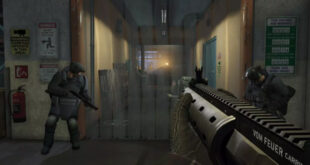Do shareholders know something we don’t?
Last year was a triumph for Take-Two. Critically, it was named the No.1 games publisher by review aggregator Metacritic. Commercially, it was the biggest boxed games firm in the US and No.2 in the UK.
GTA V’s launch was the largest in entertainment history. 32.5m have been sold into retail. And that’s before we even consider BioShock orNBA 2K14 or WWE.
So why has its share price remained largely unchanged?
I have never met a CEO who didn’t think his stock price was too low,” says Strauss Zelnick, CEO and chairman of Take-Two.
Our strategy is to be the most creative, innovative and efficient company in the business. Our results are nothing short of extraordinary.
And it’s across the board. It is the extraordinary success of GTA V, of NBA 2K14, of WWE, of BioShock, Borderlands, Civilization V and its add-on packs, and the massive growth we’ve experienced in digital. It’s a ‘firing on all cylinders’ story and I’m not sure why it doesn’t resonate more.
But I am a big believer that if you put one foot in front of another and never take anything for granted, then over time the market’s view and reality tend to converge.”
"The problems Take-Two has experienced
in the deployment of GTA Online highlights the
expertise gap that needs to be filled."
– Christine Arrington, IHS
There is one big reason why shareholders may be twitchy around Take-Two. For all its success, this is a publisher that has its feet firmly placed in the ‘old games industry’.
For the first nine months of its financial year, just 13 per cent of Take-Two’s revenue came from digital online products, while 93 per cent comes from the console space.
Analysts have criticised the firm for its strong reliance on physical retail. Yet, in truth, this should not matter.
Even if retailers were to disappear overnight, it’s not as if Take-Two is incapable of selling its titles via other means. And it is in IP like GTA, BioShock, Red Dead, Borderlands and so on, that the publisher’s strengths truly lie.
Consumers don’t focus on how they get their stuff,” adds Zelnick. They focus on quality, convenience and price. And we want to be where they are.”
The assumption that Take-Two is behind its rivals when it comes to digital is unfair. This is a publisher that was one of the first to invest in DLC with its GTA IV add ons – Lost and Damned and Ballad of Gay Tony.
And alongside GTA V the firm launched the free-to-play GTA Online. Take-Two generated around 40m from microtransactions last quarter, primarily via that game.
However, despite its success GTA Online struggled to cope with the demand to begin with, and Rockstar felt compelled to compensate fans with in-game currency.
It sparked one analyst (IHS’ Christine Arrington) to say: The problems Take-Two has experienced in the deployment of GTA Online highlights the expertise gap that needs to be filled.”
Yet, this ‘expertise’ issue is not one exclusive to Take-Two. Even MMO giants Blizzard encountered launch issues with 2012’s Diablo III, while EA – which has a massive digital business – botched the launch of last year’s SimCity.
"Before Angry Birds was launched, the
company behind it had 50 unremarkable
launches. Even the biggest and best in
the mobile space has a low hit ratio."
– Strauss Zelnick, Take-Two
Analysts are also be wary of Take-Two’s lack of success in mobile.
Last year the publisher invested in smartphones by bringing the likes of XCOM to the devices, developing companion apps for NBA and GTA, along with building original IP such as strategy game Haunted Hollow. But success has been hard to find.
Everyone has found mobile difficult,” explains Zelnick.
The leader in this space is Angry Birds and it’s no secret that before Angry Birds came the company that launched it had something like 50 unremarkable releases, and since then it has had 50 unremarkable launches. That is not meant critically, because it is just a reflection that even the biggest and best in the space has a low massive hit ratio.
The performance of our mobile titles that are unrelated to our other IP have been largely disappointing, although luckily not meaningful from a financial point-of-view.”
Mobile is unpredictable and for every success there are countless failures. If Zelnick and his team truly want a mobile hit, it may have to buy one (and with almost $1bn in the bank, it has the means to do).
But in truth, Take-Two’s strength is not in mobile, it’s in triple-A console games. And in many ways it is doing it better than its competitors.
Games such as Assassin’s Creed and Call of Duty appear to have suffered from franchise fatigue in recent years. These games have come out annually, and the strategy appears to be: make as much money out of these brands as quickly as possible, before gamers get bored and move on (which is a legitmate strategy in its own right).
In fact, Activision expects its new IP Destiny to have a ten year lifespan.
Take-Two wants its IP to last forever, and as a result will take its time between sequels.
We think it is great that consumers anticipate our titles in the same way that they anticipate the next James Bond film. Our goal is to create permanent franchises like that,” says Zelnick.
However, Zelnick adds that in today’s market, he doesn’t have to wait for GTA VI in order to generate more money from that IP.
Just a few years ago, we’d launch a title in physical form and then we would sell catalogue versions. Today we launch a title, we often – if not always – put out DLC and now we have recurrent consumer spending, where players can engage and spend money on an on-going basis.
70 per cent of people that have played GTA V while connected to the internet have played GTA Online. And recurrent consumer spending, which includes revenue from GTA Online, represented nearly half of our digital revenue in the quarter. So people are voting that they want to stay engaged and they are voting with their wallets.”
"Since 2007 we have put out one multi-million
selling new franchise every year. We would like to
try and maintain that track record."
– Strauss Zelnick, Take-Two
This is why I feel shareholders have got Take-Two wrong. It may not be experiencing growth in areas that its rivals are, but it’s not suffering the declines its competitors are enduring, either.
Take-Two has a strong portfolio. It tends to hit a good quality bar, and has managed to retain some of its most talented designers, namely 2K’s Ken Levine and Rockstar’s Housers.
And what’s more, it’s developing new blockbusters, too.
Since 2007 we have put out one multi-million unit selling new franchise every year,” says Zelnick.
I’m not saying we will always get to do that but we would certainly like to pursue and maintain that track record. We have more than ten titles in development for what is now this new generation of consoles, and it’s a mixture of franchises that already exist and new IP that we hope will become future franchises.”
Take-Two may generate much of its money f

 MCV/DEVELOP News, events, research and jobs from the games industry
MCV/DEVELOP News, events, research and jobs from the games industry



